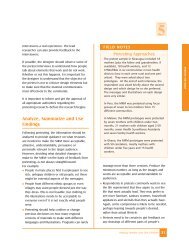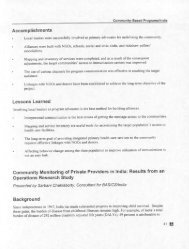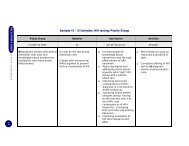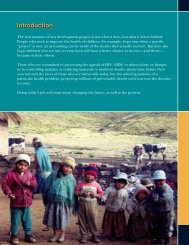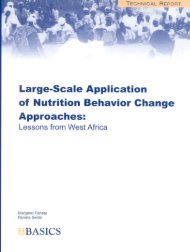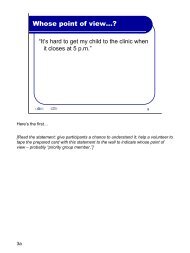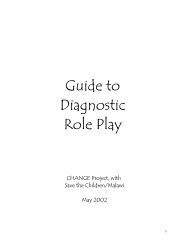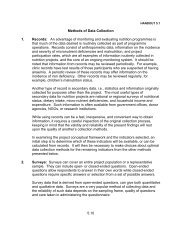Using Data to Improve Service Delivery - A Self-Evaluation Approach
Using Data to Improve Service Delivery - A Self-Evaluation Approach
Using Data to Improve Service Delivery - A Self-Evaluation Approach
Create successful ePaper yourself
Turn your PDF publications into a flip-book with our unique Google optimized e-Paper software.
Center for Applied Research on Population and Development (CERPOD)<br />
CILSS<br />
USING DATA<br />
TO IMPROVE SERVICE DELIVERY<br />
A <strong>Self</strong>-<strong>Evaluation</strong> <strong>Approach</strong><br />
United States Agency for International Development (USAID)<br />
Bureau for Africa, Office of Sustainable Development<br />
Sahel Institute (INSAH)<br />
Sahel Institute (INSAH)
<strong>Using</strong> <strong>Data</strong> <strong>to</strong> <strong>Improve</strong> <strong>Service</strong> <strong>Delivery</strong>:<br />
A <strong>Self</strong>-<strong>Evaluation</strong> <strong>Approach</strong><br />
May 2003<br />
Anne LaFond<br />
Eckhard Kleinau<br />
Lonna Shafritz<br />
Suzanne Prysor-Jones<br />
Fara Mbodj<br />
Baba Traore<br />
Etienne Dembele<br />
Mouhamadou Gueye<br />
Dr. Mountaga Bouaré<br />
Christine Snow
This publication was produced by the Support for Analysis and Research in Africa (SARA) Project, operated by the Academy for Educational Development<br />
with subcontrac<strong>to</strong>rs Tulane University, JHPIEGO, Morehouse School of Medicine, and Population Reference Bureau. SARA is funded by the U.S. Agency for<br />
International Development through the Bureau for Africa, Office of Sustainable Development (AFR/SD) under Contract No. AOT-00-99-00237-00.<br />
For additional copies or information, contact:<br />
Support for Analysis and Research in Africa (SARA) Project<br />
Academy for Educational Development<br />
1825 Connecticut Avenue, NW<br />
Washing<strong>to</strong>n, DC 20009 USA<br />
Tel: 202-884-8000<br />
Fax: 202-884-8447<br />
E-mail: sara@aed.org<br />
Center for Applied Research on Population and Development (CERPOD)<br />
B.P. 1530<br />
Bamako, Mali<br />
Tel: 223-22-47-06<br />
Fax: 223-22-78-31<br />
Pho<strong>to</strong> credits:<br />
Cover: Pirozzi, UNICEF ♦ Page 4: Anne LaFond ♦ Page 6: Anne LaFond ♦ Page 12: Njamburi/Cabak, ELS ♦ Page 15: JHU/CCP<br />
Page 25: UNICEF ♦ Page 41: Liz Gilbert, courtesy of the David and Lucile Packard Foundation ♦ Page 57: Luke Mwanza, JHU/CCP<br />
Page 73: Harvey Nelson ♦ Page 89: H. Kakande, DISH II Project ♦ Page 105: Elizabeth Serlemitsos, JHU/CCP<br />
One or more pho<strong>to</strong>s courtesy of M/MC Pho<strong>to</strong>share at www.jhuccp.org/mmc.<br />
The opinions expressed in this paper those of the authors and not necessarily those of USAID, AED, JSI, MEAUSRE, or CERPOD.
Table of Contents<br />
Acknowledgments ..................................................................................................................................................................... v<br />
Part 1................................................................................................................................................................................................ 1<br />
Introduction......................................................................................................................................................................................................3<br />
Part II ................................................................................................................................................................................................ 9<br />
Sources of <strong>Data</strong> for <strong>Self</strong>-<strong>Evaluation</strong> ....................................................................................................................................................... 11<br />
Part III Identifying Needs and Resolving Problems with <strong>Data</strong>: Five Steps <strong>to</strong> <strong>Self</strong>-<strong>Evaluation</strong> of<br />
Health <strong>Service</strong>s ......................................................................................................................................................... 23<br />
Essential <strong>Service</strong>: Antenatal Care (ANC) .............................................................................................................................................. 25<br />
Essential <strong>Service</strong>: Assisted <strong>Delivery</strong> ...................................................................................................................................................... 41<br />
Essential <strong>Service</strong>: Preventive Infant Visit (PIV) .................................................................................................................................. 57<br />
Essential <strong>Service</strong>: Childhood Immunization ...................................................................................................................................... 73<br />
Essential <strong>Service</strong>: Family Planning ........................................................................................................................................................ 89<br />
Essential <strong>Service</strong>: Community Involvement in Health Care Management ...........................................................................105<br />
iii
Annexes<br />
Annex 1: Indica<strong>to</strong>r Definitions .............................................................................................................................................................. A-2<br />
Annex 2: Blank Tables ............................................................................................................................................................................A-13<br />
Annex 3: Glossary—Words You Should Know ..............................................................................................................................A-23<br />
Annex 4: Help Section ...........................................................................................................................................................................A-25<br />
iv
Acknowledgments<br />
This guide represents a collaborative effort on the part of the<br />
Center for Applied Research on Population and Development<br />
(CERPOD), the Support for Analysis and Research in Africa<br />
(SARA) project, and the Moni<strong>to</strong>ring and <strong>Evaluation</strong> <strong>to</strong> Access<br />
and Use Results (MEASURE) <strong>Evaluation</strong> project. The following<br />
people have contributed <strong>to</strong> its conception and realization: Anne<br />
LaFond (MEASURE <strong>Evaluation</strong>), Lonna Shafritz (SARA), Fara<br />
Mbodj (formerly CERPOD), Mouhamadou Gueye (CERPOD),<br />
Etienne Dembele (consultant, CERPOD), Baba Traore<br />
(CERPOD), Christine Sow (formerly CERPOD), Suzanne<br />
Prysor-Jones (SARA), and Eckhard Kleinau (formerly<br />
MEASURE).<br />
The authors received technical guidance and encouragement<br />
from many people.<br />
Our sincere thanks go <strong>to</strong> the health staff of the Koulikoro<br />
Region in Mali for their participation in the initial field test of<br />
the guide and <strong>to</strong> Dr. Mountaga Boure, Regional Direc<strong>to</strong>r of<br />
Public Health in Koulikoro, for supporting this field test. Alec<br />
Moore (MEASURE <strong>Evaluation</strong>) assisted with revisions of the<br />
tables and graphs. Finally, the authors thank the United States<br />
Agency for International Development, Bureau for Africa, Office<br />
of Sustainable Development for providing the resources for<br />
producing this self-evaluation guide.<br />
v
Part 1<br />
1
Introduction<br />
1. What Is the Purpose of this Guide?<br />
This guide will help frontline health workers use the data<br />
collected at health facilities <strong>to</strong>:<br />
♦ Solve common problems in service delivery; and<br />
♦ <strong>Improve</strong> their response <strong>to</strong> community needs.<br />
It is intended for doc<strong>to</strong>rs, nurses, and midwives in communitybased<br />
health centers. The overall aim of the guide is <strong>to</strong> promote<br />
greater use of existing service data <strong>to</strong> improve health services. It<br />
does not require health workers <strong>to</strong> collect any additional data.<br />
3
2. Why Should Health Workers Use <strong>Data</strong> for Problem Solving?<br />
The following s<strong>to</strong>ry will help answer this question.<br />
Meet Mary and Kadija<br />
Mary and Kadija work at Kasemeni health center. Mary is a<br />
nurse and Kadija is a midwife. They have worked at Kasemeni<br />
for four years, providing services <strong>to</strong> the communities living in<br />
this area. After all this time working in Kasemeni, Mary and<br />
Kadija feel that they understand the health problems in the<br />
community quite well. After all, most people come <strong>to</strong> the health<br />
center with the same problems month after month. Children<br />
have respira<strong>to</strong>ry infections and diarrhea, many people come <strong>to</strong><br />
the center with malaria in the rainy<br />
season, and sometimes pregnant women<br />
seek care after they deliver. Although she<br />
promotes antenatal and well-baby care,<br />
Kadija finds that the community’s interest<br />
in these preventive services remains<br />
limited. Mary and Kadija are pleased that<br />
they can help people solve some of their<br />
health problems.<br />
However, they would like <strong>to</strong> improve the services they provide<br />
and work more effectively with the community <strong>to</strong> address health<br />
needs.<br />
<strong>Using</strong> registers and patient record cards, Mary and Kadija<br />
record information about the people seen at the health center<br />
each day. At the end of each month, Mary tallies the<br />
information and sends a report <strong>to</strong> the district health office.<br />
Sometimes she wonders about the purpose of collecting all this<br />
information.<br />
Many health workers like Mary do not realize that the data they<br />
collect each day can be used right at the facility <strong>to</strong> solve<br />
problems in service delivery as well as<br />
community health problems in general.<br />
For example, Kadija knows that many<br />
women do not come <strong>to</strong> her for antenatal<br />
care. But without looking at the data, she<br />
does not know how many pregnant<br />
women in the community are not receiving<br />
the benefits of antenatal care, nor does she<br />
know where these women live. This<br />
information can help her define the<br />
problem of low antenatal coverage and<br />
find ways <strong>to</strong> address it.<br />
4
In addition, if attendance at the clinic improves following an<br />
information, education, and communication (IEC) campaign<br />
about the benefits of antenatal care, Kadija can use health data<br />
<strong>to</strong> determine whether coverage has improved a little or a lot.<br />
It is possible for Kadija <strong>to</strong> answer each of the following<br />
questions using census data on the population and facility data<br />
collected at the health center:<br />
♦ How many pregnant women in the community do not<br />
receive antenatal health care?<br />
♦ Where do these women live?<br />
♦ Has coverage of antenatal care improved a little or a lot?<br />
With data she could estimate the actual number of pregnant<br />
women in the community, set a target or goal for reaching a<br />
certain percentage of these women, and then measure whether<br />
her efforts <strong>to</strong> improve coverage have been successful. While<br />
Kadija can report this information <strong>to</strong> the district management<br />
team or the supervisor as evidence of her efforts, the data is<br />
probably most useful <strong>to</strong> Kadija herself. She can understand<br />
the strengths and weaknesses of the health service and work<br />
with other health staff and the community <strong>to</strong> make<br />
improvements where they are needed. This process of<br />
examining data <strong>to</strong> assess problems and find solutions is called<br />
self-evaluation.<br />
This guide will help you learn how <strong>to</strong> conduct self-evaluation<br />
at your facility and use data <strong>to</strong> improve your capacity <strong>to</strong> meet<br />
health needs in your community.<br />
5
3. Who Benefits from <strong>Self</strong>-<strong>Evaluation</strong>?<br />
Conducting self-evaluation of health services using data already<br />
collected at the health facility can help health workers in many<br />
ways. Overall, self-evaluation will enable health workers <strong>to</strong><br />
assess problems and discover new strategies for improving<br />
health services. Specifically, analyzing and interpreting data<br />
assists health workers <strong>to</strong>:<br />
♦ Identify and understand community needs and problems;<br />
♦ Identify and understand health service needs and problems;<br />
♦ Help the community understand the<br />
extent of their health problems and<br />
identify solutions;<br />
♦ Set priorities each period (month,<br />
quarter, etc.) for facility- and<br />
community-based activities;<br />
♦ Moni<strong>to</strong>r the results of facility- and<br />
community-based health interventions<br />
<strong>to</strong> solve health problems; and<br />
♦ Use resources such as medicine and<br />
supplies more effectively.<br />
<strong>Data</strong> that describe a problem or show that you have been<br />
successful in solving a problem can also be presented <strong>to</strong> your<br />
supervisors and managers <strong>to</strong>:<br />
♦ Demonstrate your ability <strong>to</strong> conduct self-evaluation and<br />
improve health services; and<br />
♦ Support a request for additional resources such as staff,<br />
equipment, supplies, drugs, transportation, and fuel.<br />
Information can also be used <strong>to</strong> engage<br />
people in the community in improving<br />
health services and addressing major<br />
health problems in the community.<br />
Health workers can present data <strong>to</strong><br />
community leaders <strong>to</strong>:<br />
♦ Demonstrate that the health services<br />
are an important part of the<br />
community; and<br />
♦ Demonstrate the benefits of working<br />
<strong>to</strong>gether <strong>to</strong> solve health problems.<br />
6
4. How Do I Use this Guide <strong>to</strong> Conduct <strong>Self</strong>-<strong>Evaluation</strong>?<br />
As you read this guide, you will find in each section:<br />
♦ A s<strong>to</strong>ry about a common problem that health workers face<br />
when they deliver basic health services. Each s<strong>to</strong>ry describes<br />
one worker’s efforts <strong>to</strong> try <strong>to</strong> reach people with specific<br />
health needs—such as pregnant women—and the problems<br />
associated with attracting people <strong>to</strong> the health service or<br />
providing good quality health care.<br />
Following each s<strong>to</strong>ry you will find:<br />
♦ Some suggestions about moni<strong>to</strong>ring and evaluating these<br />
essential services using census and facility data. The guide<br />
encourages health workers <strong>to</strong> use information already<br />
available at the health center or district health office <strong>to</strong><br />
improve their understanding of a specific problem, devise<br />
ways <strong>to</strong> address it, and moni<strong>to</strong>r improvements that result<br />
from these efforts.<br />
Clearly, most health workers are already aware of many of these<br />
problems without having <strong>to</strong> use data. The purpose of this guide<br />
is <strong>to</strong> help you gain a deeper understanding of a specific problem<br />
by using data <strong>to</strong> measure its size, identify who is affected most<br />
by it, and assess whether the problem is becoming larger or<br />
smaller over time. It will help you answer questions such as:<br />
♦ What percentage of children in the community has not<br />
received three doses of DPT and OPV?<br />
♦ Where do these children live?<br />
♦ Is the percentage of children who have not received three<br />
doses of DPT and OPV becoming larger or smaller?<br />
♦ How can we improve immunization coverage at our health<br />
facility?<br />
While there are many indica<strong>to</strong>rs that may be used <strong>to</strong> assess<br />
performance, the guide suggests that you use one key indica<strong>to</strong>r<br />
for moni<strong>to</strong>ring the performance of each essential service (see<br />
Annex 1). Indica<strong>to</strong>rs will relate <strong>to</strong> health services coverage or<br />
the quality of management. The guide explains how <strong>to</strong> take<br />
data that is already available at the health center and calculate<br />
this indica<strong>to</strong>r. The guide then suggests ways <strong>to</strong> use this<br />
information <strong>to</strong> make improvements in coverage and<br />
management. To help you record data, calculate indica<strong>to</strong>rs, and<br />
present your findings, step-by-step instructions and blank forms<br />
are found in the annexes.<br />
7
<strong>Self</strong>-evaluation is not difficult, but it can take time. It works<br />
best when health workers take a special interest in improving<br />
their ability <strong>to</strong> meet health needs in the community. To be<br />
effective evalua<strong>to</strong>rs, health workers should also receive<br />
5. Performing <strong>Self</strong>-<strong>Evaluation</strong><br />
Five Steps of <strong>Self</strong>-<strong>Evaluation</strong><br />
support from their managers and supervisors. <strong>Self</strong>-evaluation<br />
involves five steps. These five steps are illustrated in the<br />
diagram below and explained later in the guide.<br />
Step 1<br />
Choose an indica<strong>to</strong>r<br />
Step 2<br />
Analyze the data<br />
Step 3<br />
Evaluate the situation<br />
Step 4<br />
Find a solution<br />
Coverage or quality<br />
of the services/management<br />
Define the indica<strong>to</strong>r<br />
Calculate the indica<strong>to</strong>r<br />
Interpret the indica<strong>to</strong>r<br />
Present the data<br />
Is there a problem ?<br />
Is the problem serious ?<br />
Where is the problem ?<br />
Identify the priorities<br />
Develop a plan of action<br />
Work with the community<br />
What are the causes ?<br />
Find a solution<br />
Will the situation get better ?<br />
Step 5<br />
Moni<strong>to</strong>r the results of the plan of action<br />
Calculate the indica<strong>to</strong>rs<br />
Is the situation getting better?<br />
8
Part II<br />
9
Sources of <strong>Data</strong> for <strong>Self</strong>-<strong>Evaluation</strong><br />
1. Introduction<br />
<strong>Self</strong>-evaluation uses two types of data. The first type is:<br />
Community <strong>Data</strong><br />
Community data includes information on the <strong>to</strong>tal population<br />
that should be served by the health services (also called the<br />
catchment population). Examples are:<br />
♦ Names of all the villages and cities served;<br />
♦ Population of each village, city, or catchment area;<br />
♦ Names of influential people in the area and in each<br />
community; and<br />
♦ Names of members of the health center management<br />
committee.<br />
The second type of data is:<br />
Facility <strong>Data</strong><br />
Facility data includes information on the people that actually<br />
attend the health service and information on the management of<br />
the health services. Examples are:<br />
♦ Names, sex, and location of clients seen;<br />
♦ Diagnosis and services provided; and<br />
♦ Records of meetings held, etc.<br />
Both types of data are described in the following pages.<br />
11
2. Community <strong>Data</strong><br />
Health workers should know as much about their community as<br />
possible. The more they know, the more effective they are likely<br />
<strong>to</strong> be. For example, they should know the size of the<br />
population, where people live, and<br />
characteristics of the population in<br />
different communities. Are people<br />
poor? Are they farmers or nomads?<br />
They should also be aware of the most<br />
influential individuals that can help<br />
resolve problems or motivate the<br />
community. This information helps<br />
health workers understand the<br />
community’s needs and the obstacles <strong>to</strong><br />
improving health in the community.<br />
Ideally, each health center should have<br />
the following information available:<br />
♦ A map that covers all the communities<br />
served by the health facility;<br />
♦ A list of all villages served;<br />
♦ Population figures for the whole catchment area and specific<br />
target groups;<br />
♦ Population figures for each village and target groups within<br />
each village;<br />
♦ A list of influential individuals in the community; and<br />
♦ A list of individuals on the health center management<br />
committee.<br />
Population figures for each village can be found in census<br />
reports. From these numbers you can calculate the <strong>to</strong>tal<br />
population of your catchment area. 1 The population for different<br />
target groups, such as<br />
pregnant women, can then be<br />
calculated using the percentages noted<br />
in Table A on the following page.<br />
These percentages are based on the<br />
composition of populations found in<br />
the majority of African countries.<br />
Blank tables can be found in Annex 2<br />
at the end of this document.<br />
1<br />
In many countries, population figures are outdated. You should use the<br />
most recent population figures that are available. Sometimes the National<br />
Bureau of Statistics will provide population projections for the years following<br />
a census. Large national surveys such as the Demographic and Health<br />
Survey (DHS) can also be a reliable source of population data. You may<br />
want <strong>to</strong> discuss this issue with your district health management team and<br />
determine the best source of data for calculating population sizes for your<br />
catchment area.<br />
12
TABLE A: Population Figures<br />
Health center: Kasemeni Year: 2002<br />
Total population of the catchment area (catchment population)<br />
Total population of pregnant women in the catchment area<br />
Total population of women of child-bearing age in the catchment area<br />
Total population of children aged 0 <strong>to</strong> 11 months in the catchment area<br />
Total population of children aged 12 <strong>to</strong> 23 months in the catchment area<br />
Total population of children aged 0 <strong>to</strong> 35 months in the catchment area<br />
Total population living within a range of 0 <strong>to</strong> 5 km of the health center<br />
Total population living farther than 5 km from the health center<br />
Percentage of<br />
<strong>to</strong>tal population<br />
100%<br />
5%<br />
24%<br />
4%<br />
4%<br />
11%<br />
No formula<br />
No formula<br />
Your community<br />
10,000<br />
500<br />
2,400<br />
400<br />
400<br />
1,100<br />
After you make these calculations, you can display the data in<br />
tables, such as Tables B and C on the following pages. These<br />
tables are only examples. To complete a table for your catchment<br />
area, use the blank tables in Annex 2. These tables may be<br />
copied for recording information for each village. To complete<br />
the tables, you will need information on the approximate distance<br />
from the village <strong>to</strong> the health center (either less than or<br />
more than 5 km) as well as the population of each village.<br />
13
TABLE B: Village Population and Size of Target Groups<br />
Health center: Kasemeni Year: 2002<br />
Village<br />
Total<br />
population<br />
Pregnant<br />
women<br />
5%<br />
Women of<br />
child-bearing age<br />
24%<br />
Children<br />
0-11 months<br />
4%<br />
Children<br />
12-23 months<br />
4%<br />
Children<br />
0-35 months<br />
11%<br />
Villages less than 5 km<br />
1. Mwavumbo<br />
2. Mtaa<br />
3. Mwabilla<br />
4. Mwatete<br />
5. Kalalani<br />
6. Mwamdudu<br />
7. Bofu<br />
8. Msambweni<br />
Total 5km<br />
790<br />
1570<br />
380<br />
510<br />
3250<br />
40<br />
79<br />
19<br />
26<br />
164<br />
190<br />
377<br />
91<br />
122<br />
780<br />
32<br />
63<br />
15<br />
20<br />
130<br />
32<br />
63<br />
15<br />
20<br />
130<br />
87<br />
173<br />
42<br />
56<br />
358<br />
Total population<br />
10,000<br />
504<br />
2400<br />
400<br />
400<br />
1102<br />
14
Influential Individuals in the Community<br />
In the table below, you can list the influential individuals in the<br />
community (at least one per village). There are many different<br />
people who might be included in this list: the village head,<br />
president of the women’s organization, teachers, traditional birth<br />
attendants, traditional healers, etc. These are people who can<br />
help mobilize the community and reach target groups with<br />
health messages. In the example below, empty spaces have been<br />
left for you <strong>to</strong> add other influential people in your area. Blank<br />
tables are found in Annex 2.<br />
TABLE C: Influential Individuals in the Community<br />
Health center: Kasemeni Year: 2002<br />
Village<br />
1. Baurem<br />
2. Mamissa<br />
Names<br />
Villages less than 5 km<br />
(Insert each person’s name here)<br />
Positions<br />
Village Head/President<br />
Teacher<br />
President of women’s group<br />
Traditional healer<br />
Village Head/President<br />
Teacher<br />
President of women’s group<br />
Traditional healer<br />
15
Village<br />
3. Mwabilla<br />
TABLE C (continued): Influential Individuals in the Community<br />
Health center: Kasemeni Year: 2002<br />
Names<br />
Villages less than 5 km<br />
(Insert each person’s name here)<br />
Positions<br />
Village Head/President<br />
Teacher<br />
President of women’s group<br />
Traditional healer<br />
4. Mwatete<br />
5. Kalalani<br />
6. Mwamdudu<br />
7. Bofu<br />
8. Msambweni<br />
1. Kenango<br />
2. Kafundi<br />
3. Mwashanga<br />
4. Mgandini<br />
Villages 5 km or more<br />
(Insert each person’s name here)<br />
Village Head/President<br />
Teacher<br />
President of women’s group<br />
Village Head/President<br />
Teacher<br />
Religious leader<br />
16
Health Center Management Committee<br />
The health center management committee helps guide the work<br />
of the health center and forms one link between the health<br />
workers and the community.<br />
In Table D, list the management committee members and their<br />
positions. This information should be updated each year.<br />
TABLE D: Health Center Management Committee<br />
Health center: Kasemeni Year: 2002<br />
Member (name)<br />
1.<br />
Function<br />
Head/President<br />
2.<br />
Secretary<br />
3.<br />
Treasurer<br />
4.<br />
Community Organizer<br />
Continue <strong>to</strong> the last member<br />
17
3. Facility <strong>Data</strong><br />
Registers and Cards<br />
The type of information you collect at the health facility is<br />
contained in the daily records kept on each person that visits the<br />
health center. Before you begin the self-evaluation, you should<br />
review your registers and cards and make sure they are filled out<br />
properly. Ask yourself these questions:<br />
♦ Are you recording all the necessary information on each<br />
patient, or are there some blank spaces in the registers and<br />
cards?<br />
♦ Can you read all the words and numbers written there? Is<br />
the writing clear?<br />
♦ Is the information accurate? Are there pieces of information<br />
that do not make sense or indicate a mistake in practice or<br />
recording, such as a measles immunization given <strong>to</strong> a child<br />
that is five months old?<br />
<strong>Self</strong>-evaluation of health services works best when your facility<br />
data is complete, clearly written, and accurate. If you find<br />
problems with the information recorded in the registers, take<br />
steps <strong>to</strong> fix these problems for all the records kept from <strong>to</strong>day<br />
onwards. Even if the data you recorded in the past is<br />
incomplete, DO NOT go back and try <strong>to</strong> change the<br />
information already written in the registers. It is <strong>to</strong>o difficult <strong>to</strong><br />
recall accurately what has happened in the past, and you risk<br />
recording the wrong information.<br />
Monthly/Quarterly Reports<br />
The information you collect in the cards and registers is used <strong>to</strong><br />
write the monthly/quarterly report. A tally sheet is often used <strong>to</strong><br />
count the number of visits for different services and conditions,<br />
and the <strong>to</strong>tal is then written in the monthly/quarterly report.<br />
When conducting self-evaluation, it is important that the tally<br />
sheets and monthly/quarterly reports are complete, clear, and<br />
accurate. Check your tally sheets for any problems and take<br />
steps <strong>to</strong> fix these problems for all the tally sheets made from<br />
<strong>to</strong>day onwards. Before you send your tally sheet or monthly/<br />
quarterly reports <strong>to</strong> either the district health office or the<br />
Ministry of Health, be sure <strong>to</strong> keep a copy of it for your records.<br />
Indica<strong>to</strong>rs<br />
Below you will find a list of essential health services or activities<br />
and a key indica<strong>to</strong>r that can be used <strong>to</strong> moni<strong>to</strong>r the performance<br />
of that activity. Each indica<strong>to</strong>r is discussed in detail in the next<br />
section. These indica<strong>to</strong>rs are only suggestions. In Annex 1, you<br />
will find additional indica<strong>to</strong>rs that could be used for moni<strong>to</strong>ring<br />
and evaluation at a basic health facility.<br />
18



